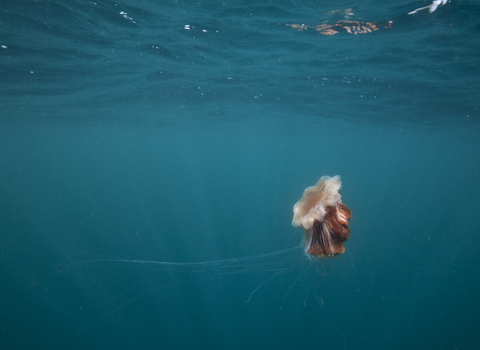
Lion's mane jellyfish ©Alex Mustard/2020VISION
Lion's mane jellyfish
The long mane of tentacles that stream out from the lion's mane jellyfish is stunning… literally! Look but don't touch when it comes to these jellyfish - they give a powerful sting.
Scientific name
Cyanea capillataWhen to see
May to OctoberAbout
It's easy to see where the lion's mane jellyfish gets its name from: the long flowing tentacles that surround the bell have all the beauty and bite of a lion. Up to 3m in length, these tentacles are packed with stinging cells and are used to catch their favourite prey: fish and other smaller jellyfish. Lion's mane jellyfish give a very nasty sting, so consult a doctor if swelling or weals are severe. In the meantime, scrape the area with a clean stick or remove the tentacle with tweezers if you have them to hand, then rinse the area with warm to hot water to reduce swelling.How to identify
A translucent brown to reddish jellyfish with a thick mane of hundreds of long hair-like tentacles; the oldest of which are coloured dark red. They have thick, frilled oral arms under the bell, most often brownish in colour.Distribution
Found off all UK coasts in summer months.Did you know?
Fragments of the lion's mane jellyfish's tentacles will sting you even if they're no longer attached to the jellyfish! They will still sting long after they've been on the shore.Watch
Lion's mane jellyfish by Bex Lynam (https://vimeo.com/352222011/998ce237de)
Video by Bex Lynam
